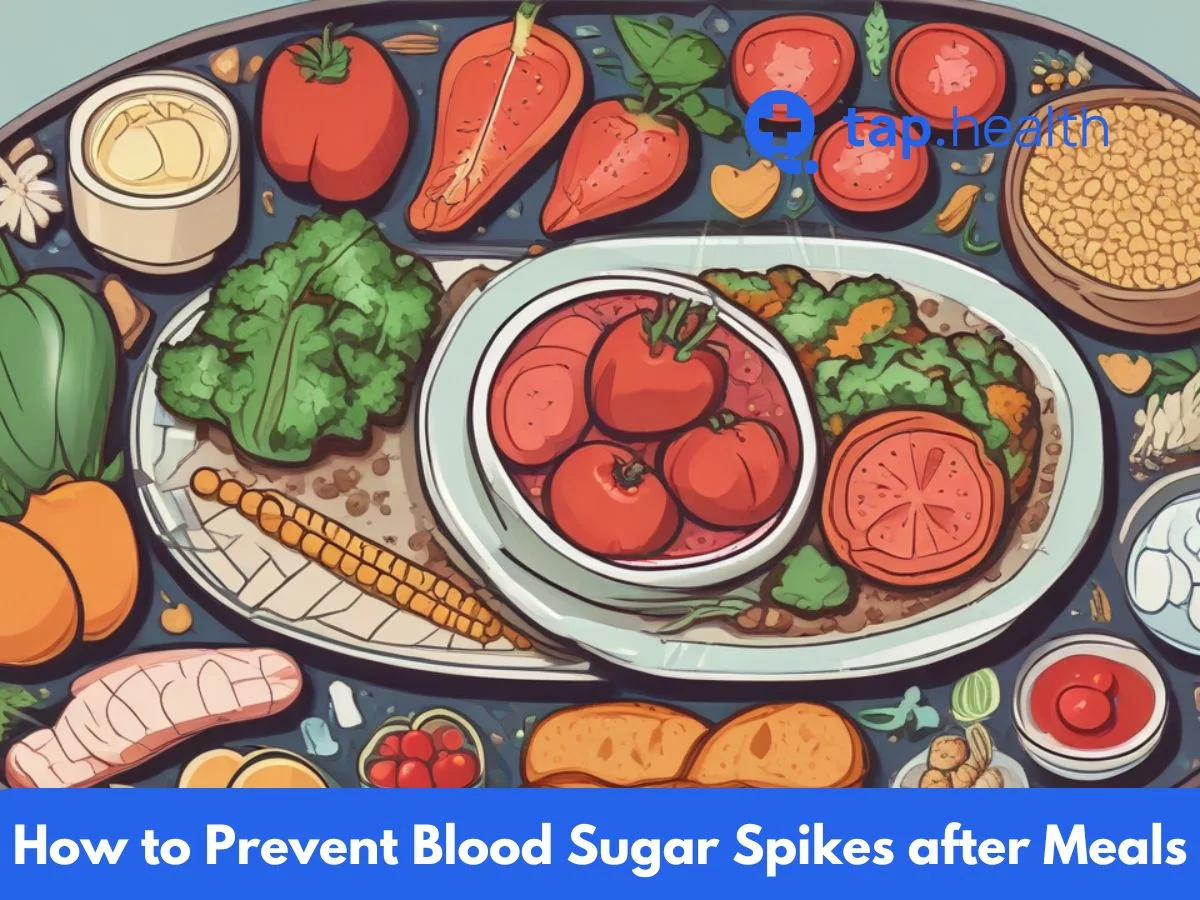Managing blood sugar levels is crucial for everyone, especially for people with diabetes or those at risk of developing it. Blood sugar spikes after meals can lead to various health complications, including fatigue, mood swings, and long-term damage to vital organs. Fortunately, there are simple and practical steps you can take to prevent these spikes. In this article, we’ll explore how to prevent blood sugar spikes after meals with easy-to-follow strategies and tips.
Why Do Blood Sugar Spikes Happen?
Before we dive into how to prevent blood sugar spikes, it’s important to understand why they happen in the first place. After you eat, your body breaks down carbohydrates into glucose, which enters your bloodstream. Normally, your pancreas releases insulin, a hormone that helps move glucose from the blood into your cells for energy.
However, if your body is unable to produce enough insulin or use it effectively (as in the case of diabetes), glucose builds up in the bloodstream, leading to high blood sugar levels. Certain foods and lifestyle factors can cause blood sugar to rise more quickly than others. Understanding these causes can help you make better choices for managing your blood sugar.
How to Prevent Blood Sugar Spikes After Meals
Here are some simple and effective strategies you can implement to prevent blood sugar spikes after meals:
1. Choose Low Glycemic Index (GI) Foods
The Glycemic Index (GI) measures how quickly a food raises blood sugar levels. Foods with a high GI cause a rapid spike in blood sugar, while those with a low GI cause a slower, more gradual increase.
Low GI foods include:
- Whole grains (e.g., oats, quinoa)
- Non-starchy vegetables (e.g., spinach, broccoli)
- Legumes (e.g., lentils, beans)
- Berries (e.g., strawberries, blueberries)
High GI foods include:
- White bread
- Potatoes
- Sugary snacks and desserts
Opting for low GI foods helps slow down the digestion process, leading to more stable blood sugar levels after meals.
2. Add Protein and Healthy Fats to Your Meal
Incorporating protein and healthy fats into your meals can help stabilize blood sugar levels. Protein helps slow down the digestion of carbohydrates, while healthy fats provide lasting energy without spiking blood sugar.
Good sources of protein:
- Lean meats (chicken, turkey)
- Fish (salmon, tuna)
- Plant-based proteins (tofu, tempeh, legumes)
Healthy fats include:
- Avocados
- Nuts and seeds (almonds, chia seeds)
- Olive oil
A balanced meal with protein and healthy fats not only helps regulate blood sugar but also keeps you feeling full for longer.
3. Watch Your Portion Sizes
Overeating, even healthy foods, can lead to higher blood sugar levels. Eating large portions of high-carbohydrate meals can overwhelm your body’s ability to manage the glucose from the meal, resulting in spikes.
It’s essential to control portion sizes, especially for foods high in carbohydrates. Eating smaller, more frequent meals throughout the day can help prevent large spikes in blood sugar. Use smaller plates and bowls to control portions and try eating slowly to give your body time to signal when it’s full.
4. Include Fiber-Rich Foods
Fiber helps slow the absorption of glucose into the bloodstream, preventing rapid blood sugar spikes. A high-fiber diet also promotes better digestion and overall gut health.
Fiber-rich foods include:
- Whole grains (brown rice, barley)
- Vegetables (carrots, Brussels sprouts)
- Fruits (apples, pears)
- Legumes (beans, lentils)
Adding more fiber to your meals helps regulate blood sugar and can even reduce the risk of developing type 2 diabetes.
5. Stay Hydrated
Drinking enough water is an often-overlooked aspect of blood sugar management. Staying hydrated helps the kidneys flush out excess glucose from the bloodstream. Dehydration can make it harder for the body to regulate blood sugar levels effectively.
Aim to drink at least eight 8-ounce glasses of water a day. If you’re active, you may need more. Herbal teas and water-rich fruits like watermelon and cucumber can also help with hydration.
6. Exercise Regularly
Exercise is one of the most effective ways to lower blood sugar levels. Physical activity helps your muscles use glucose for energy, which reduces blood sugar levels. Even light exercises like walking, yoga, or swimming can help prevent blood sugar spikes.
Try these tips for incorporating exercise into your routine:
- Take a brisk walk after meals to help lower blood sugar.
- Aim for at least 30 minutes of moderate exercise most days of the week.
- Incorporate strength training exercises, which improve insulin sensitivity.
7. Avoid Sugary Beverages
Sugary drinks like soda, sweetened teas, and fruit juices are among the leading causes of blood sugar spikes. These drinks are quickly absorbed into the bloodstream, leading to rapid increases in blood sugar levels.
Instead of sugary drinks, opt for water, unsweetened herbal teas, or sparkling water. If you’re craving something sweet, try flavored water with a splash of lemon or cucumber for a refreshing, low-calorie alternative.
8. Manage Stress
Chronic stress can cause blood sugar levels to rise. When you’re stressed, your body releases hormones like cortisol, which can increase blood sugar levels. Stress also tends to trigger unhealthy eating habits, such as reaching for comfort foods.
Tips to manage stress include:
- Practice mindfulness or meditation.
- Take breaks throughout the day to relax.
- Engage in activities that help you unwind, such as listening to music or spending time with loved ones.
9. Get Enough Sleep
Poor sleep is linked to higher blood sugar levels and insulin resistance. When you don’t get enough rest, your body produces more stress hormones, which can increase blood sugar. Aim for 7 to 9 hours of sleep each night to help regulate your blood sugar and improve overall health.
10. Monitor Your Blood Sugar Levels
Regularly monitoring your blood sugar levels can help you understand how different foods and activities affect your blood sugar. This is especially important for people with diabetes or those at risk of developing it. By keeping track of your blood sugar, you can identify patterns and make adjustments to your diet and lifestyle accordingly.
FAQ on How to Prevent Blood Sugar Spikes After Meals
1. What are the signs of blood sugar spikes after meals?
Blood sugar spikes can cause symptoms like fatigue, excessive thirst, frequent urination, blurred vision, and headaches. If left unmanaged, they can lead to more serious health issues like nerve damage, kidney problems, and heart disease.
2. How long does it take for blood sugar to spike after a meal?
Blood sugar typically starts to rise within 10-15 minutes after eating, peaking about 30 minutes to 2 hours after a meal, depending on the type of food consumed. The rise is usually higher after eating high-carb or sugary meals.
3. Can stress cause blood sugar spikes?
Yes, stress can cause blood sugar levels to spike. When you’re stressed, your body releases stress hormones, like cortisol, which can make your body more resistant to insulin and lead to higher blood sugar levels.
4. How can I lower my blood sugar quickly?
Some quick ways to lower blood sugar include drinking water to stay hydrated, engaging in light exercise like walking, and avoiding high-carb or sugary foods. If you have diabetes, following your healthcare provider’s advice and taking medications as prescribed is also essential.
5. What foods can I eat to prevent blood sugar spikes?
Foods that are high in fiber, protein, and healthy fats can help prevent blood sugar spikes. Focus on whole grains, vegetables, fruits with low glycemic indexes, lean proteins, and healthy fats like avocados and nuts.
By following these tips and making simple lifestyle changes, you can significantly reduce the chances of blood sugar spikes after meals and improve your overall health. Managing your blood sugar is crucial for preventing long-term complications and maintaining your quality of life. Always consult with a healthcare provider before making any significant changes to your diet or exercise routine, especially if you have diabetes or other medical conditions.



